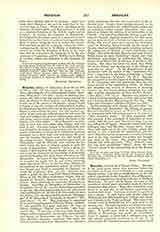

Heraclea, a titular see of Thracia Prima. Heraclea is the name given about four centuries before the Christian era to the town of Perinthus, a very ancient Samian colony, built like an amphitheatre on the hillside of a peninsula in the Propontis (Sea of Marmora). It became famous because of its resistance to Philip of Macedonia. Its port and its happy situation at the junction of several great sea-routes, made it a town of commercial importance. Many of its coins have come down to us, and give us information concerning the festivals held there. Justinian restored its aqueducts and a palace. It now forms part of the vilayet of Adrianople, has 2000 inhabitants, Turkish and Greek, and is known to the Turks as Eregli. The ruins of the ancient town of Heraclea are on a cape close to the modern one. Heraclea became a see at an early date: according to a Greek tradition it dates from apostolic times. It would seem that in the beginning the Bishop of Byzantium was under its jurisdiction. Later it appears to have had 5 suffragan sees, and this number gradually increased to 15 and 17. A little before the Ottoman conquest the number stood at 6; then it fell to 5 once more; in our days it has but two (Myriophyton and Metrae).
The Metropolitan of Heraclea has retained the title of Exarch of Thrace and Macedonia. He resides at Rodosto and not at Eregli. It is his privilege to hand the newly appointed Patriarch of Constantinople his crozier. Lequien (Oriens Christianus, I, 1101 sqq.) gives a list of 48 titulars, which might easily be increased. Among the names are: St. Philip, martyr (feast October 22); Paederos, present at the Council of Nicaea in 325; Theodorus, an Arian, author of a commentary on the Scriptures, who played a rather important part between 335 and 351; Hypatius, a Semi-Arian, deposed in 365; Dorotheus, an Arian, 366; Sabinus, a Macedonian; John, the friend and correspondent of Photius; Nicetas, eleventh century, a writer of commentaries and other works; Pinacas, who accepted the union with Rome proclaimed at Lyons in 1274; Philotheus, a Palamite, Patriarch of Constantinople in 1354; Antonius, who signed the Union at Florence; Neophytus, Joannicius, Methodius, and Callinicus, Patriarchs of Constantinople in 1636, 1646, 1668, and 1726. At one time Heraclea treasured the relics of St. Glyceria, a virgin martyred at Trani (feast May 13). In the thirteenth century Heraclea had Latin bishops in residence (Lequien, “Or. Christ.”, III, 965; Eubel, “Hierarchia catholica medii aevi”, I, 283). Three other towns bearing the same name were episcopal sees; two in Caria, suffragans of Stauropolis, and the Heraclea of Pontus in Honorias, suffragan of Claudiopolis.
S. PETRIDES

